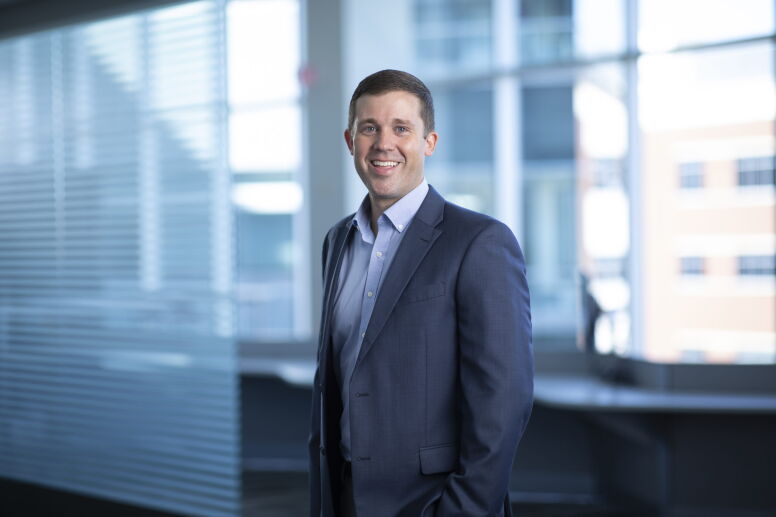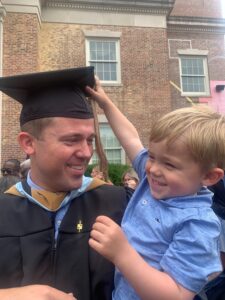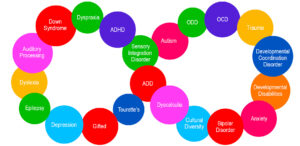News & Stories
Learning about neurodiversity inspires change

Joe Williams (BA ’11, MBA ’23) thought it was the perfect time to pursue his MBA. 
On parental leave after the birth of his second child, he reflected on how he could advance his professional skills while he and his wife were raising their sons in Richmond, Virginia.
To advance professionally, Williams enrolled in the online MBA program, MBA@UNC, at UNC Kenan-Flagler Business School.
His subsequent educational journey did more than turn him from a communications specialist into a businessperson. It also transformed his thinking and opened a world of possibility, a world that is more inclusive.
Something important got started when Professor Ivonne Chirino-Klevans turned her class discussion to neurodiversity – a term Williams had never heard of – and he immediately began researching the topic.
Neurodiversity refers to the range of differences in the way the brain functions and people behave, and often is used to describe autistic spectrum disorders. Williams was both moved and fascinated when he learned that adults who are neurodivergent have an 80% or higher unemployment rate.
He checked in with his colleagues at Altria, where he is a senior manager in regulatory engagement, to see if the firm had a formal hiring program for adults who are neurodivergent. There wasn’t one. He decided it was an untapped talent pool that deserved the same opportunity afforded to him.
And with that special lesson from his MBA class, he decided to become part of the solution to that high unemployment rate, starting with his organization.

Neurodiversity infinity symbol
Considering untapped talent
“To create more inclusive and accepting workplace environments for adults who are neurodivergent, you start with empathy,” says Williams. “The people we’re hiring don’t look like your typical hires. They don’t have the resumes of typical hires. They wouldn’t even get to the interview stage if they had to go through our typical application process. You try to break the mold and get people comfortable with being uncomfortable.”
Williams is among leaders changing the face of the workforce. With remote work now mainstream, employment among people with disabilities hit a post-pandemic high: It climbed by about 175,000 in June 2023 to 7.6 million, higher than at any point since this data became available in 2008, according to the Bureau of Labor Statistics.
Here’s Williams’ playbook for getting started.
Step 1: Make the business case.
Getting employers on board requires time, patience and commitment. After Williams conducted his due diligence and learned all he could about hiring adults who are neurodivergent. He reached out to people on LinkedIn, looked at what other companies were doing, and talked to internal sources, including decision-makers, influencers, hiring managers and HR.
Then he built a business case.
“This is a hiring strategy to help a team accomplish its business objectives, and it has a trickle-down impact on our culture and community,” says Williams. “It’s not charity work or volunteerism. There’s no reason a business can’t do well by doing good.”
He suggests creating “carve out” roles with a 20- to 40-hour work week. He asked colleagues what tasks need to get done but are deprioritized and what tasks take time away focusing on higher priority work.
“Don’t look for the roles that first come to mind,” says Williams. “Push yourself to think beyond those jobs and hire people for roles that align with their interests and passions.”
At Altria that’s meant hiring employees who handle data validation, support corporate audits and conduct data analysis programming using Python.
Demonstrating the tasks employees could potentially do and how much time that would give back to others in the organization is part of the business case. During a labor shortage, having another talent pool is a gift, says Williams.
He partnered with others who wanted to help. With a team of five, he set out to convince company leaders, and they took their case all the way to the CEO.
“If you get buy-in from the leadership at the top, then it makes everything so much easier and removes so many barriers,” says Williams. “As the program grows, as time passes by, you’ll need more support, more resources, more budget.”
Step 2: Find partners in the community.
To fill open roles with the talented pool of candidates who are neurodivergent, they began identifying potential partners. Nonprofits, colleges and universities with special programs, and community organizations can help organizations find potential job candidates who are neurodivergent. Altria partners with Virginia Commonwealth University Rehabilitation Research and Training Center (VCU-RRTC).
These groups also can help organizations transform the hiring process. For instance, some adults who are neurodivergent are not very expressive. Some don’t show the same emotional cues hiring managers expect to see. Help people who make hiring decisions recognize that behavioral interviews could look different, says Williams.
Altria started small and has hired four employees who are neurodivergent, so far. They are acclimating well into their teams and making contributions to the business, says Williams.
One employee, in his first weeks on the job, noticed several data errors and proposed changes. Another employee accomplished in five hours what takes a neurotypical employee much longer.
Focusing on Altria’s unique needs was an important part of the planning. “Develop a plan that matches with your company and how your company operates and its processes and systems,” says Williams. “Every company is unique.”

Step 3: Change hearts and minds.
Focus on raising awareness and providing education to key stakeholders: your employees. Help them understand the hiring strategy’s value to the business and the missed opportunity you overlook a talented candidate who is neurodivergent.
Changing their mindset is one of the biggest challenges, says Williams. “It’s asking people to take a leap of faith. It’s correcting biases and removing deeply rooted stigmas.”
Williams and his team used VCU-RRTC staff’s knowledge to provide neurodiversity training, equipping colleagues with insights into what they can anticipate and how to assist new hires. VCU-RRTC also provides job coaches who work closely with the new hires to help them settle into their role and acclimate to the company.
Step 4: Make accommodations.
Adults who are neurodivergent exhibit a range of behaviors – some are less expressive, while others might speak loudly and many have different social inhibitions – which can raise concerns about how an employee who is neurodivergent will fit in socially or if they can do the job.
Altria has made accommodations to set each hire up for success. Some use noise-canceling headphones to help them stay focused and avoid distractions. And others take breaks and use calming mechanisms.
When one employee feels overwhelmed, he pulls Minesweeper up on his computer. Another had his mom ask the team if he could wear shorts in the office because he tends to get hot while sitting in one place for a while.
“If he’s uncomfortable, he’s not going to do his best work,” says Williams. “If he comes in and does his job, that’s all that matters.”
Another important step is creating the correct documentation and resources that are specific with clear-cut processes and steps with some visuals, says Williams. While a few changes to the traditional way of doing things might be needed, the onboarding process in terms of time and resources is no different than hiring a neurotypical employee.
Step 5: Assess the program.
Like any workplace program, hiring candidates who are neurodivergent requires regular assessments. Is this working? Are the employees benefitting? Is the company benefitting? Should the company hire more or fewer candidates? What’s happening during the trial period?
Williams and his team ask these questions regularly. They also involve HR in a more formal way now that the hiring has begun.
Starting small is a good way to keep from getting overwhelmed and test best practices.
Adults who are neurodivergent are a large, untapped talent pool and can benefit he organization, he says.
“It’s been challenging to get people to realize that these candidates are like you and me at the end of the day,” says Williams. “If there are any myths out there that an adult who is neurodivergent could not contribute to a business, they have been proven wrong. Our new hires are doing fantastic work and showing us they deserve to be included in our workforce hiring strategy as equally as neurotypical employees.”